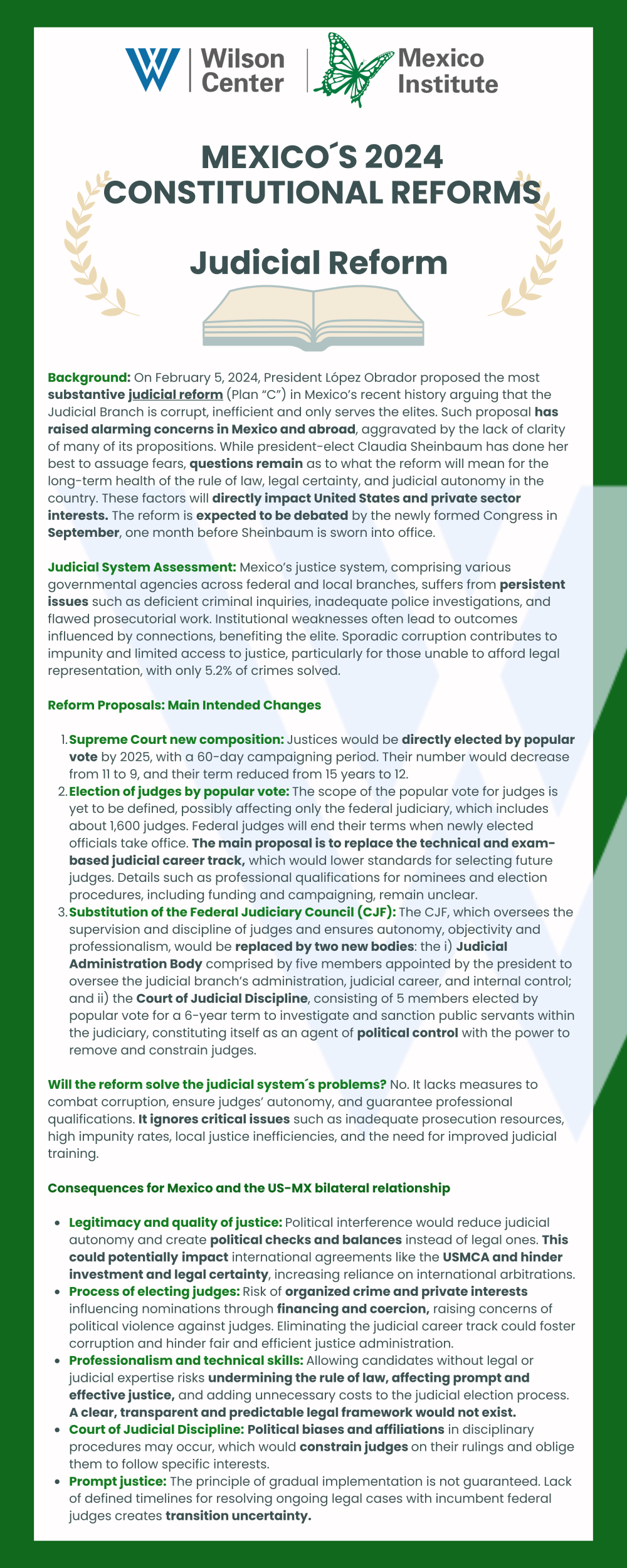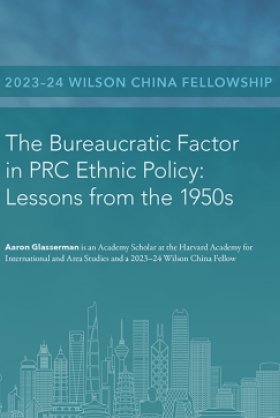Mexico's Constitutional Reforms Series | Judicial Reform
Welcome to the Mexico Institute's infographic series on Mexico’s Constitutional Reforms which will examine and provide brief one-pagers of the main reforms President López Obrador (AMLO) proposed on February 5, 2025. These reforms represent a transformative phase in Mexico’s legal framework, comprising 20 critical constitutional and legal initiatives addressing various societal and governmental structure changes. These initiatives span a spectrum of critical areas, including labor rights, environmental protections, judicial autonomy, electoral dynamics, and the state’s economic role. President López Obrador has championed these reforms by arguing that they will consolidate Mexico’s democratic gains and advance socio-economic development. Join us as we navigate each infographic, unpacking the rationale, impact, and potential implications of these constitutional reforms on Mexico and the US-MX bilateral relationship. Understanding and envisioning these reforms is crucial, especially as the new congress will convene in September, just one month before AMLO leaves office. This period will be pivotal, as López Obrador aims to pass his priority reforms. President-elect Claudia Sheinbaum has already publicly declared her intention to adopt the reform package as her own and ensure thorough discussions on some of the proposals.

On February 5, 2024, President López Obrador proposed the most substantivejudicial reform(Plan “C”) in Mexico’s recent history arguing that the Judicial Branch is corrupt, inefficient and only serves the elites.
MEXICO´S 2024 CONSTITUTIONAL REFORMS
Judicial Reform
Background: On February 5, 2024, President López Obrador proposed the most substantive judicial reform (Plan “C”) in Mexico’s recent history arguing that the Judicial Branch is corrupt, inefficient and only serves the elites. Such proposal has raised alarming concerns in Mexico and abroad, aggravated by the lack of clarity of many of its propositions. While president-elect Claudia Sheinbaum has done her best to assuage fears, questions remain as to what the reform will mean for the long-term health of the rule of law, legal certainty, and judicial autonomy in the country. These factors will directly impact United States and private sector interests. The reform is expected to be debated by the newly formed Congress in September, one month before Sheinbaum is sworn into office.
Judicial System Assessment: Mexico’s justice system, comprising various governmental agencies across federal and local branches, suffers from persistent issues such as deficient criminal inquiries, inadequate police investigations, and flawed prosecutorial work. Institutional weaknesses often lead to outcomes influenced by connections, benefiting the elite. Sporadic corruption contributes to impunity and limited access to justice, particularly for those unable to afford legal representation, with only 5.2% of crimes solved.
Reform Proposals: Main Intended Changes
Supreme Court new composition: Justices would be directly elected by popular vote by 2025, with a 60-day campaigning period. Their number would decrease from 11 to 9, and their term reduced from 15 years to 12.
Election of judges by popular vote: The scope of the popular vote for judges is yet to be defined, possibly affecting only the federal judiciary, which includes about 1,600 judges. Federal judges will end their terms when newly elected officials take office. The main proposal is to replace the technical and exam-based judicial career track, which would lower standards for selecting future judges. Details such as professional qualifications for nominees and election procedures, including funding and campaigning, remain unclear.
Substitution of the Federal Judiciary Council (CJF): The CJF, which oversees the supervision and discipline of judges and ensures autonomy, objectivity and professionalism, would be replaced by two new bodies: the i) Judicial Administration Body comprised by five members appointed by the president to oversee the judicial branch’s administration, judicial career, and internal control; and ii) the Court of Judicial Discipline, consisting of 5 members elected by popular vote for a 6-year term to investigate and sanction public servants within the judiciary, constituting itself as an agent of political control with the power to remove and constrain judges.
Will the reform solve the judicial system´s problems? No. It lacks measures to combat corruption, ensure judges’ autonomy, and guarantee professional qualifications. It ignores critical issues such as inadequate prosecution resources, high impunity rates, local justice inefficiencies, and the need for improved judicial training.
Consequences for Mexico and the US-MX bilateral relationship
Legitimacy and quality of justice: Political interference would reduce judicial autonomy and create political checks and balances instead of legal ones. This could potentially impact international agreements like the USMCA and hinder investment and legal certainty, increasing reliance on international arbitrations.
Process of electing judges: Risk of organized crime and private interests influencing nominations through financing and coercion, raising concerns of political violence against judges. Eliminating the judicial career track could foster corruption and hinder fair and efficient justice administration.
Professionalism and technical skills: Allowing candidates without legal or judicial expertise risks undermining the rule of law, affecting prompt and effective justice, and adding unnecessary costs to the judicial election process. A clear, transparent and predictable legal framework would not exist.
Court of Judicial Discipline: Political biases and affiliations in disciplinary procedures may occur, which would constrain judges on their rulings and oblige them to follow specific interests.
Prompt justice: The principle of gradual implementation is not guaranteed. Lack of defined timelines for resolving ongoing legal cases with incumbent federal judges creates transition uncertainty.
The content discussed is based on the original proposals presented by President López Obrador in February of this year.
The reforms will be discussed by the newly elected Congress starting September 1, so the proposals' contents may change.
About the Author

María Calderón
María Calderón is a Program Associate for the Mexico Institute at the Wilson Center.
Read More
Mexico Institute
The Mexico Institute seeks to improve understanding, communication, and cooperation between Mexico and the United States by promoting original research, encouraging public discussion, and proposing policy options for enhancing the bilateral relationship. A binational Advisory Board, chaired by Luis Téllez and Earl Anthony Wayne, oversees the work of the Mexico Institute. Read more













